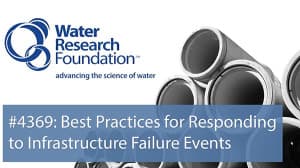Water Research Foundation: Best Practices Training Videos
Using video to make best practices training more compelling
The Water Research Foundation (WRF) uses research dollars from more than 950 subscribing organizations in the United States and abroad to tackle an array of issues related to the treatment and delivery of clean drinking water. WRF has worked with partners for 45 years to identify, prioritize, fund, manage, and communicate scientifically sound research across the globe.
Challenge
Many water utility staff across North America have little or no experience in dealing with legal and claims management issues that arise before, during, and after infrastructure failure events, such as water main breaks. In order to remedy this capacity gap, WRF worked with Cadmus to develop a best practices guide for water utilities to address these issues.

Cadmus was well equipped for the task. Drinking water has been a core business for us since our founding in 1983, and we have deep expertise in identifying and disseminating best technical, management, and financial practices for the water utility industry and its stakeholders.
In the course of developing the guide, WRF and Cadmus scanned the industry and found that there were no training videos that covered best practices in legal and claims management issues from the water utility perspective. In order to fill this void, WRF expanded the project with Cadmus to include the development of training videos that combine expert guidance and footage from the field to share best risk-management practices in a compelling, easy-to-absorb way.

Cadmus recognized that the videos needed to bring to life the best practices outlined in the print guide, include testimony from industry experts, and demonstrate the “dos and don’ts” of dealing with infrastructure failure, while staying within WRF’s established budget. Cadmus produced the videos in just three months to meet WRF’s timeline, budget and deliverable needs.
Solution
Cadmus developed three videos that focus on the most important steps in dealing with the legal and claims issues related to water infrastructure failures:
- One presented the best practices for handling an infrastructure failure, encompassing effective planning and documentation, rapid response, and clear communication during an event as well as thorough documentation after the event.
- The second focused on dealing with infrastructure failures caused by a third party (e.g., another utility, the phone company, the cable company), in which a utility has to respond while also determining and communicating the responsibility of the third party in resolving legal and insurance claims.
- The third depicted “what not to do” in preparing for or dealing with an infrastructure failure, clearly showing the real world consequences of not properly planning for a failure.

Each video conveyed detailed and compelling information on best practices, based on the material in the print guide. The videos were broken out into shorter segments to allow instructors and/or viewers to review best practices on an individual basis.
This project drew on precisely the multidisciplinary collaboration at which Cadmus thrives. Bringing together in-house experts in environmental science and strategic communications, we combined thorough understanding of drinking water and utility management with video production capacity to develop scripts, schedule, and manage production. This included on-camera interviews with managers at DC Water in Washington, DC, and compilation of video from utilities across North America.
Results
In just three months, Cadmus produced three training videos, ranging in length from five to 12 minutes. Along with the best practices guide developed by Cadmus, the videos—available on WRF’s website—will help utility staff, consulting engineers, lawyers, and risk management professionals who serve the drinking water industry.
